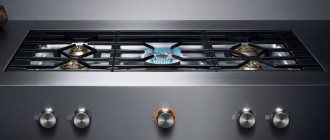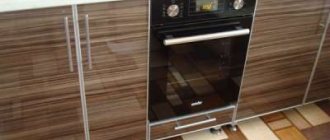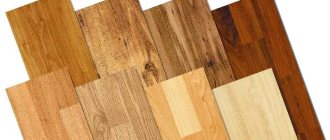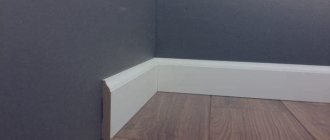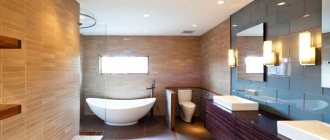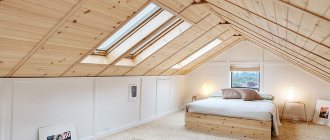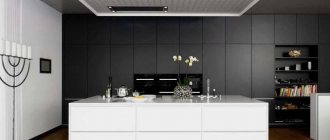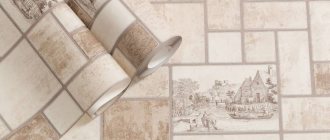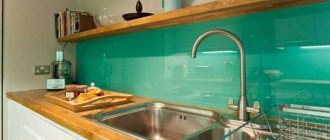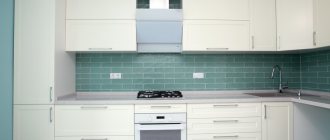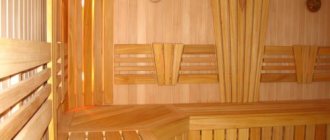X
The variety of floor coverings that have appeared on the building materials market in recent years has not been able to move linoleum from the pedestal of the most popular. It fits seamlessly into the interior of any room, including bedrooms, kitchens and children's rooms, can withstand the highest loads and compares favorably in price with other flooring.
Most often, linoleum flooring can be found in the kitchen. Despite the fact that linoleum is considered a fairly simple material, its choice requires the most careful approach to the type, texture, color and installation methods. Only with proper calculations and following step-by-step instructions can you not worry about the longevity of your kitchen floor.
Why linoleum in the kitchen
Helpful information:
- Choosing flooring for the kitchen
- Is it possible to lay tiles on linoleum?
- How to choose wood impregnation
- How to choose impregnation for concrete
- Which toilet is better to choose and buy?
- Which foundation is better for a house made of timber?
The kitchen, without exaggeration, can be called the most frequently used room in the entire house. In addition to the fact that all family members spend a lot of time here, the kitchen floor also experiences heavy loads from temperature changes and high humidity. And here, too, the possibility of difficult-to-clean greasy stains is greatest. Therefore, the choice of linoleum for this room should be based on the following factors:
- Hygiene and moisture resistance. The floor covering should not be afraid of frequent cleaning using household chemicals and large amounts of moisture.
- Lowest level of hygroscopicity. The material must be absolutely resistant to moisture absorption.
- Non-slip surface of the kitchen floor, even when wet.
- Resistance to the development of fungus, insects or microorganisms in the material.
- Preservation of the original appearance. Intense load associated with the movement of household members and frequent movement of furniture should not affect the appearance of the floor covering or its functionality.
- Strength, relative to mechanical impact. Dropped sharp objects or broken dishes should not damage the kitchen floor.
For a longer service life of linoleum, it is recommended to choose a roll of material in such a way that during flooring it is possible to reduce the number of welds, that is, so that a solid sheet almost completely covers the kitchen floor.
What to look for when purchasing
Before buying this or that material for your kitchen floor, check a few important points:
- Does the label indicate the manufacturer, production address and contact information?
- Does the seller have a certificate for goods from this batch?
- Does the selected material have a strong unpleasant odor?
- Is there a defect on the inner or outer surface?
- The drawing should be clear without blurred areas.
- The surface must be homogeneous - embossed or smooth.
- If the flooring in a room will consist of two pieces, it is important to ensure that both pieces are from the same batch, otherwise there may be a mismatch in shade or tone.
Choice of color and shade
You can choose the shade and pattern of linoleum to suit any interior style. There are floor coverings that imitate stone or ceramic tiles, marble, wood, and other materials.
For the kitchen, you should choose flooring material of variegated colors , so that small stains on it are invisible. Do not purchase plain light-colored coatings, as they are susceptible to frequent cleaning using household chemicals.
Although modern types of PVC are covered with a special protective film, household chemicals contribute to the destruction of this film. Floor coverings that imitate wood look good in any interior.
Preparing the floor for laying flooring
Before laying the flooring, make sure that the subfloor is level and rigid. The thinner the covering material you choose, the smoother and more ideal the floor on which it will be laid should be.
If you have old linoleum laid in your kitchen and there is no serious damage to it, then a new coating can be laid on top of it . Concrete floors are best leveled with pre-leveling mortars. Such solutions are poured onto the floors and leveled with special tools.
Plywood floors are prepared using wood putty. is coated with a primer before installation . This measure protects the floors from mold. Before laying the covering, the floor is thoroughly vacuumed.
Types of linoleum
Linoleum is usually divided into a couple of types, each of which has its own characteristics:
Natural linoleum . For production, lime or cork conglomerate, crushed to a powder, various wood resins, linseed oil and natural pigments for coloring are used. The mixture is fixed on a natural base of jute or flax fibers.
The production technology has changed quite little since its original release. Modernization processes mainly affected only the stages of drawing, as well as aspects of the durability of linoleum colors.
The main advantages of natural linoleum coating can be considered:
- environmental friendliness;
- long service life (up to 45 years);
- resistance to aggressive effects of household chemicals and sunlight;
- increased wear resistance even with the most unsparing use;
- good heat and sound insulation;
- antiseptic properties, manifested through the use of linseed oil in the coating composition;
- low level of absorption of moisture, dirt and grease, which makes cleaning such a floor in the kitchen quick and easy;
- natural linoleum does not cause allergic reactions and can be safely used even in families with small children.
The only disadvantage of natural linoleum coating is its high price compared to artificial analogues. That is why it is more often used in bedrooms or children's rooms, and for places with high traffic, coatings made from budget, artificial components are chosen.
Synthetic linoleum . This flooring is not as durable as natural flooring (use for no more than 15 years, depending on the quality of the materials), but still has many advantages.
Synthetic linoleum can be polyvinyl chloride (PVC), alkyd, colloxyl or rubber. However, not all of these types are suitable for use in residential premises.
Colloxyl linoleum, created on the basis of nitrocellulose, is very durable and wear-resistant, but has an increased fire hazard. Its use in residential buildings and public places is strictly prohibited. Rubber linoleum is optimally suited for warehouse and industrial buildings, as well as for sports fields.
Glyphthalic flooring, created on a fabric basis, could be used in apartments, but is not in particular demand due to the complexity of installation and poor resistance to temperature changes.
PVC linoleum is the leader in installation in residential premises. Experts claim that it is absolutely safe for human health, non-toxic and does not cause allergies, with the exception of very rare cases associated with individual intolerance.
A linoleum coating consisting of several layers is called heterogeneous. If the material does not have a base and consists of only two layers (main and protective), then it is a homogeneous type.
How to remove old paint from walls
Heterogeneous PVC coating used in living areas and kitchens is a multi-component structure that includes:
- basis;
- PVC backing;
- special layer for strength. Most often made of fiberglass;
- thin layer of PVC;
- decorative film. It can be either plain or have a variety of patterns or imitations of wood or stone;
- transparency - a layer to increase the wear resistance of the coating, reaching a thickness of up to 0.7 mm;
- protective film.
The composition of the homogeneous version is much simpler, since, in fact, it has only one layer, and the pattern, if any, is applied to the surface itself, and does not appear as a separate film. The durability of homogeneous linoleum is quite high, and its appearance, even after prolonged wear, remains quite presentable. This coating is usually quite thin, but sometimes you can find sheets 15mm thick. Such models are not often used for finishing kitchen floors, as they are completely inexpensive.
Laying the floor in the kitchen with polyvinyl chloride linoleum has many advantages:
- this floor meets all the requirements for a kitchen floor;
- the material is easy to clean and does not require additional effort;
- linoleum has good moisture resistance and low gyroscopicity;
- PVC coating is not susceptible to mechanical damage and is not prone to abrasion;
- the average service life of such flooring is 15 years and above;
- affordability in comparison with laminate or parquet boards;
- ease of installation. You can do the flooring in the kitchen yourself without hiring hired workers;
- manufacturers offer a huge variety of color and texture solutions that will fit into the interior of any kitchen;
- Some models have a top relief layer that prevents slipping.
Which color should I choose?
Since this material has no seams, it is very easy to care for, so you can safely choose almost any color. However, despite these qualities, it is still advisable to give preference to non-monochrome options, with patterns and inclusions, since if stains occur that are difficult to remove, they will be invisible on this coating.
Otherwise, the choice of color must be coordinated with the design and style of the interior. Colors that are too dark and monochromatic are also considered to be easily soiled, as stains from water and detergents will be visible on them.
There is a particularly great variety of options that imitate wood and parquet floors, which will fit perfectly into many interiors, for example, into a modern Scandinavian style or into a classic style.
For classic interiors and rustic-style floors, it is ideal to choose a design that imitates stone or stone-look tiles.
Modern linoleum is quite durable. It's also extremely easy to maintain - a quick mop is all it takes to keep it perfectly clean. It's ideal if you don't have the budget to treat yourself to a wood floor. The right floor covering will be a real decoration of the interior. It also requires much less maintenance than wood floors and is easy to install.
The material can be easily cut to any size with a sharp knife. The main factor in installation is proper preparation of the substrate. It should be smooth, without any cracks, holes, cleaned of dirt, small fragments and stones that can damage the material, especially quite thin ones. All protrusions should be removed, otherwise they will be clearly visible on the floor, which will certainly affect the aesthetics of the interior.
Unfortunately, despite its many advantages, linoleum also has disadvantages. One of the biggest is the high susceptibility to mechanical damage.
Classification, characteristics and areas of application
The performance qualities of linoleum are divided into three main classes, based on which you can determine the scope of its use. The class of linoleum coating is always indicated by a two-digit number, where the first number indicates the purpose, and the second – the degree of resistance to mechanical and abrasive loads.
If the first number is 2, then linoleum is suitable for housing, 3 means the material will serve well for office floors, retail and social establishments, and number 4 indicates models that work well in industrial buildings.
The following classes are in great demand:
- Commercial (industrial) material, designated by markings from 41 to 43. This linoleum has a dense but transparent protective film of polyurethane, reaching 0.7 mm thick. This coating serves well in workshops of industrial enterprises, logistics centers, and warehouses. The high performance capabilities of this class are not in demand in residential premises that do not have such an increased load.
- Semi-commercial linoleum. The protective layer of this linoleum has a thickness of about 0.5 mm and is marked with classes from 31 to 34. Its purpose is office floors, social and retail outlets. This material is designed for increased intensity of use due to its durable surface that is resistant to abrasive loads. Class 33 and 34 are coatings that can withstand the most maximum and even extreme loads. Examples of use include train stations and grocery supermarkets. Laying it in an apartment is impractical, again, based on budgetary considerations. Classes 31 and 32 are optimally suited for the kitchen, where such flooring will serve for many years without changing its original condition.
- Household linoleum. The coating intended for use in residential premises is marked from 21 to 23. Such linoleum can have a protective coating up to 0.5 mm thick. It can be used in any room of an apartment or house, but its service life will be slightly shorter compared to semi-commercial linoleum.
As a kitchen floor covering, it would be a good idea to use linoleum with the following characteristics:
- semi-commercial class (31 and 32);
- textured or micro-relief surface, non-slip and moisture resistant;
- with a protective layer thickness of 0.25 to 0.3 mm, no less.
Classes of linoleum depending on purpose
Not every type of flooring material is suitable for a residential building. Also, for example, it is impossible to lay flooring intended for domestic purposes in a production workshop. Therefore, linoleum is usually divided into three classes, each of which is designated by a two-digit number.
Its first digit indicates the area of application of the material (industrial - 4, semi-commercial - 3, household - 2). The second is the degree of resistance to various external influences.
Industrial
Industrial or commercial flooring is intended only for industrial premises. It has high strength, thickness and a long service life (from 10 years).
According to the accepted numerical designation, this material is divided into three types:
- class 41 - has low wear resistance compared to other types of industrial class, used for premises where workers are mainly in a sitting position (sewing workshops, precision electronics production enterprises);
- class 42 - has a wider scope, suitable for any enterprise where workers move, but there are no heavy mechanisms and equipment;
- Class 43 is the most durable and durable material, used in rooms with heavy mobile equipment.
Industrial grade is not used in residential areas due to its high cost and poor design.
Semi-commercial
This class is used in office premises, conference rooms, hotel rooms. It has an increased level of wear resistance, high thickness and more varied colors compared to the industrial version.
The semi-commercial class is divided into the following types:
- Class 31 - used for rooms where the load on the floor is not particularly high (in classrooms, offices, hotels);
- 32 class - has increased stability, is popular in shops, boutiques, offices or residential premises with high traffic;
- Class 33 is the most durable option, intended for large office centers, classrooms, and corridors of various organizations.
The most durable option - class 33 - is practically not used in ordinary homes due to its high cost, but classes 31 and 32 are perfect for the kitchen and will last a long time.
Domestic
The most optimal and suitable option for residential premises. Its popularity is explained by its low price, varied design, good heat and sound insulation.
The household class is divided:
- 21 class - has low strength and cost, suitable for bedrooms, living rooms and dressing rooms;
- Class 22 - used in rooms with medium load: in the living room, children's room or kitchen;
- Class 23 is the most durable option for residential buildings, suitable for corridors, hallways and other rooms with high traffic volume.
The household type lasts an average of 5-12 years, depending on the quality.
Thus, for the kitchen the most optimal linoleum option would be:
- 31 and 32 classes of semi-commercial linoleum;
- 22 and 23 classes of household coating;
- the surface of the material must have a slight anti-slip texture;
- material thickness - at least 0.3 mm.
Linoleum sizes
The most common form of linoleum production is standard rolls, with a width of 1.5 to 5 m. However, there are other types of shapes that are considered more convenient for installation.
Square tiles or narrow long panels similar to laminate . This material is easy to install, perfectly imitating laminate boards, parquet, stone or ceramic tiles. The small size of the fragments allows you to install this coating yourself, even for beginners.
With proper markings and strict adherence to the lines, the installation process will be easy. Also, the advantages of this form of release include the possibility of quickly and easily dismantling a failed section of the kitchen floor and replacing it with a new one, without lifting the entire canvas.
The main disadvantage of tiled linoleum is the large number of seams, which is extremely undesirable for rooms with high humidity or high steam concentrations. Moisture or dirt between the seams can cause the material to peel away from the floor. This type of floor is washed using minimal water.
Liquid linoleum . Self-leveling flooring is an ideal choice for a kitchen floor. The seamless, monolithic surface of the coating is superior in quality to all other types of material, has a long service life and a huge variety of decorative and color solutions.
We transform a smoky room into a fresh one...
The main advantage of self-leveling flooring is its excellent waterproofing. In addition, if the need or desire arises to modify the design of the kitchen, such a covering will not need to be dismantled, since it can be used as a perfectly flat base for a new flooring.
The kitchen floor, made of “liquid” material, withstands numerous cleanings, including wet ones using a variety of household chemicals. This flooring option is absolutely safe, as it contains polymerized epoxy and polyurethane resins.
The composition is diluted right before pouring onto the floor by mixing the base component and hardener. After the mixture hardens, a moisture-resistant, smooth surface is formed on the floor, with various decorative patterns and effects. It is not entirely correct to consider self-leveling polymer floors as “liquid” linoleum, but it is this comparison that allows buyers to remember what they are looking for, and sellers to understand what exactly the buyer wants.
Choice of texture and color
Which linoleum to choose for the kitchen? Of course, you need to rely on the style being followed. Most textures and colors are fixed, so there will be no problems with the choice.
Main colors:
- Plain. Now they are becoming less and less common. As a rule, they have a matte finish without shine. For the kitchen, this option is most appropriate, since linoleum is non-slippery and easy to maintain.
- Marble. Due to the heterogeneity of the pattern, dirty, indelible stains, which in any case will appear over time, will not be so noticeable on the floor. The texture can vary from large marbled veins to faint crumbs.
- Imitation wood. Exclusively office and household class. The texture of the wood can be superficial (smooth surface with a pattern) or deep, simulating tree rings. The choice of wood is wide: wenge, oak, birch, walnut, ash, etc.
Checking the quality of linoleum for the kitchen
The quality of the linoleum coating offered by hardware stores can be judged by several fundamental points:
- Documents for each batch of linoleum must contain complete information about the manufacturer, his address and contact numbers. Such information is some guarantee that the plant is ready to answer for the quality of its product.
- Any batch of goods, regardless of its volume, must have appropriate certification, which the seller must present upon the first request of a potential buyer.
- High-quality linoleum does not have a strong unpleasant odor.
- There should be no signs of defects or minor defects not only on the front side of the material, but also on the inside.
- The surface must be uniform: smooth or textured. The exception is models where heterogeneity is provided for by the design approach or pattern.
- Pictograms on samples require special attention. They determine the sound insulation of the material, abrasion resistance, possible types of cleaning, its environmental friendliness and chemical resistance. Having finally decided on your choice, when making a purchase you should make sure that the rolls have the same batch number. Otherwise, the canvases may not fit well together in terms of seams, color and pattern.
The best manufacturers
On the construction goods market you can find various types of materials from different manufacturers to suit every taste and price.
Wide selection of linoleum
The best manufacturers producing linoleum coverings, including for the kitchen, are: Tarkett (Russia), Juteks (Slovenia), Armstrong (international concern), Grabo (Hungary), Gerflor (France) and others.
The comparison table will help you decide which linoleum is best to lay in the kitchen:
>
Design solutions for the kitchen floor
The popularity of linoleum is explained by a wide range of design solutions in patterns and color palettes that can organically fit into any interior. Without resorting to labor-intensive and low-budget work on laying stone or ceramic surfaces, you can reproduce their imitation in the kitchen using the familiar, but constantly improving linoleum.
The floor in the kitchen gets dirty quite quickly, so for this area it is better to choose linoleum with a pattern or texture that can hide minor dirt. When choosing a light material with no patterns, it is worth remembering that it will require the most frequent cleaning using all kinds of detergents. Even the presence of a protective film that protects the coating from water penetration will not help extend the life of linoleum that is subject to daily aggressive cleaning.
In the kitchen, imitation wood while preserving natural shades, as well as all kinds of textured ornaments, will look great. Variations that imitate parquet, solid wood or laminate do not go out of fashion and continue to be a current trend in interiors.
Suitable linoleum for the kitchen and hallway
Buyers of linoleum like its moisture resistance and lack of deformation from kitchen sets and other furniture. Of course, tiles and parquet are also good, but linoleum is more affordable. If you have the funds, you should choose natural linoleum for the kitchen.
It's good because:
- It is an environmentally friendly and hygienic material;
- Not afraid of fire;
- Not afraid of kitchen dirt and aggressive effects of household chemicals;
- Excellent heat retention;
- Has soundproofing properties.
The most traditional and win-win solution for the kitchen would be to choose linoleum for ceramic tiles. A stone-like material, such as marble or granite, will be effective. There is also aged linoleum that imitates worn stone or antique wood. The total thickness of the linoleum sheet for the hallway should be more than 3 mm. The protective layer on top must be more than 0.25 mm. The surface on which linoleum will subsequently be laid must be properly prepared.
How to prepare a floor for linoleum
The coating is laid only on a perfectly flat and rigid base. The smaller the thickness of the chosen type of linoleum, the more impeccably smooth the base under it should be. Even the smallest and most inconspicuous grains of construction debris remaining under the linoleum will eventually lead to wear and tear of the material and simply tear it.
If there is an old covering on the floor that is in a suitable condition, then it can not be removed by laying the new material over the old one. The main thing is that the total thickness is not very large, and you will walk around the apartment as if in a swamp. The base must be thoroughly cleaned of concrete chips, and all cracks, small gaps or chips must be sealed with a special concrete-adhesive mixture.
Read how to repair the subfloor in a separate article.
Ideal floor smoothness is achieved using various self-leveling solutions, which are leveled over the surface using professional tools. If you plan to lay linoleum on plywood, then in this case the gaps are sealed with wood putty. Coating the base with a primer helps prevent mold and creates optimal adhesion for the adhesive layer. The final stage of preparation is to thoroughly vacuum the kitchen floor.
Which linoleum is better for the kitchen - household or semi-commercial
The structure of household linoleum
A layer of protection applied to the surface protects the image and ensures abrasion resistance of the linoleum. The service life and wear resistance are determined by the thickness of the sheet. This indicator determines the division of linoleum flooring into the following types:
- Domestic;
- Semi-commercial;
- Commercial.
Despite the fact that the kitchen belongs to domestic premises, it is better to choose semi-commercial material for your choice of linoleum for the kitchen. It can withstand increased loads and has higher wear-resistant properties.
Wear resistance classification
The wear resistance of the material is classified according to the European system. According to the system, abrasion resistance is indicated by a two-digit number. The first number indicates the type of room, and the second indicates the intensity of the load. It is preferable that the class of linoleum for the kitchen should be 23, and preferably 31-32.
Laying linoleum
Laying linoleum on a properly prepared base is not at all difficult. However, minor difficulties may arise if the kitchen area has ledges, niches or corners with a complex configuration.
The linoleum must be left unrolled for 24 hours, only after which can you begin laying it. The leveled material is adjusted to the dimensions of the kitchen floor and cut. Cutting linoleum to the required size is the most important and complex process in linoleum flooring technology. It is imperative to leave a compensation gap (about 10mm) along the walls so that the cuts do not subsequently come out from under the baseboard.
Laying linoleum with your own hands: step-by-step instructions
Linoleum can be laid in two ways:
- on glue. In this case, thin linoleum is laid, which is securely attached to the prepared bottom covering, preventing moisture and fumes from penetrating;
- glueless method. This type of flooring is used in cases where thick, insulated material is being laid, so as not to deteriorate its thermal insulation properties. The adhesive solution is applied with a wide spatula and with the same spatula it is evenly distributed over the entire surface.
It is better if the area treated with glue does not exceed 75-80 cm, this will facilitate step-by-step installation. A special rubber scraper levels the glued area and pushes out all excess glue from under the linoleum.
If the coating consists of several sheets, then they are laid with an overlap of about 60-70mm, then leveled and cut using a ruler, retreating from the edge of the top sheet by about 30-35mm. This method is only suitable if the canvases are perfectly matched to each other in texture and color.
If the material does not adhere to the base, before welding it is leveled and secured together using double-sided tape.
Welding of linoleum is carried out with a special apparatus using silicone or professional glue, which can be purchased at any hardware store. This method is also called “cold welding”. The two canvases are joined together, the seam is sealed with masking tape, and then a precise cut is made right along the seam, where the glue is carefully squeezed out of the tube on the edge of a knife. After a certain period of time, the adhesive tape is removed, and a barely noticeable, but quite strong seam remains on the canvas.
Types of coatings
Floor coverings are made from natural raw materials or synthetic polymers
The material varies in structure, so experts distinguish the following varieties:
- Homogeneous - a homogeneous mixture of polyvinyl chloride granules and dye. The pattern is continuous, that is, it penetrates the entire thickness. It has increased resistance to wear and does not delaminate. The surface does not slip and does not pick up dirt and dust.
- Heterogeneous - consists of several heterogeneous layers. The substrate is foamed raw materials, fabric or non-woven fabric (provides sound insulation), the base is optical fiber, then 2 to 6 layers of polyvinyl chloride. The thickness of this coating is up to 6 mm
Depending on the presence of the base, linoleum is distinguished:
- main – has a backing (thermal insulating, made of fabric or non-woven fabric)
- baseless – a thin coating up to 3 mm thick, which wears off faster than the main one
An example of a linoleum base
The base material has increased elasticity and density, while the baseless material can only be laid on a perfectly flat surface.
Linoleum flooring can be natural or synthetic. The following varieties are distinguished:
- natural
- polyvinyl chloride (PVC)
- rubber (relin)
- glyphthalic (alkyd)
- colloxylin (nitrocellulose)
Natural
Natural material - environmentally friendly, but expensive
Natural materials are used to produce this variety:
- lime
- cork and wood flour
- natural dyes
- flax oil
- tree resin
It is considered an environmentally friendly coating that is resistant to fire and moisture, safe for people and pets. It is also convenient to use because it does not absorb fat and is able to kill harmful bacteria thanks to the flaxseed oil included in the composition.
This material does not fade or change color during use. It is not afraid of aggressive chemicals and other contaminants. Disadvantages include high cost, low elasticity, fragility and hygroscopicity.
Polyvinyl chloride
PVC coating - the best option for price-quality ratio
It can be single-layer or multi-layer, made on the basis of:
- fabrics
- foamed raw materials
- nonwoven material with thermal insulation properties
The main disadvantage is the tendency to crack, severe shrinkage under the influence of temperature and an unpleasant specific odor that does not disappear for several days.
PVC is not as expensive as natural one, because domestic manufacturers make it from local raw materials using European technologies.
It is dielectric and does not rot. Thanks to impregnation with antibacterial substances, it has bactericidal properties, and due to antifungal impregnation, it also fights other dangerous microorganisms. A wide selection of colors and patterns is available, and the material itself is easy to maintain and install.
Rubber
Relin - a reliable two-base coating
Consists of two layers: a base made of recycled bitumen or rubber and a top coat of artificial rubber and pigmented filler.
This material is plastic and not afraid of moisture.
Glypthal
Glypthal coating is fragile, but holds heat well
The most fragile type, which has good heat and sound insulation characteristics. Such linoleum is produced from alkyd resin with the addition of pigment on a fabric basis.
Before installation, the material is kept indoors for several days so that it does not deform or shrink during installation.
Colloxylin
Nitrocellulose coating is very flexible
Elastic and moisture-resistant, this type of linoleum has a glossy shine, but is defenseless against fire. Manufactured without a nitrocellulose base. Unstable to temperature changes and may shrink.
The composition contains volatile substances that are unsafe for humans, so it is not recommended to lay it in residential areas.
How to make a dog house with your own hands: arrangement of housing in the yard and in the apartment. Drawings, dimensions and original ideas (55+ Photos & Videos) + Reviews
Linoleum design in the interior
Thanks to various designs, you can choose the most suitable design that will ideally complement the overall interior picture.
Linoleum with a tile pattern
It is a fairly popular design solution that allows, at low cost, to obtain a coating with a high-quality imitation of the texture of tiles, cavities and joints between tiles.
Imitation laminate
Linoleum for laminate, parquet or boards has a very reliable appearance, is distinguished by a wealth of visual effects and a variety of color shades from light wood to dark wenge, due to which it is possible to create a calm and cozy interior. When choosing this product, it is important to take into account the correct direction of parquet or laminate strips and colors, depending on the features of the kitchen.
The photo shows the interior of a modern kitchen with linoleum imitation laminate boards.
Combined flooring in the kitchen
Linoleum goes well with other finishing materials, such as tiles, porcelain stoneware, laminate or parquet. In this way, it is possible to create a specific interior composition, focus attention on the necessary spatial areas and implement visual zoning of the kitchen. You can also add special individuality to the atmosphere if you combine linoleum of different colors, textures or patterns.
Marbled
It will give the design originality, a certain exoticism, will further emphasize the style and original interior design, and will also become an independent decoration that creates a magnificent and presentable environment.
The photo shows linoleum flooring with imitation light marble in the kitchen interior.
Imitation weed
It looks like natural grass, which allows you to create a beautiful, natural and most natural atmosphere in the space.
Geometric designs
Fashionable prints with zigzags, squares, ovals, circles, diamonds, checkered or striped coverings can not only set a certain character for the kitchen, but also influence its spatial perception in different ways.
Geometric or abstract figures can set the atmosphere as rhythmic and dynamic, as well as calm restraint and tranquility. With the help of large patterns, it is possible to create the necessary accents in the room, and thanks to small patterns, it is possible to add spaciousness and airiness to the space.
The photo shows the floor in the kitchen, decorated with linoleum with a geometric pattern in the form of multi-colored diamonds.
Patterns and prints
A variety of patterns, ornaments and unusual abstractions allow you to dilute the strict and monochromatic kitchen design and fill the atmosphere with a certain mystery and coziness. Linoleum with 3D prints has the illusion of three-dimensional space and realistically conveys the volume of the picture.
How to choose the color of kitchen linoleum?
Choosing a color scheme for the kitchen cover also requires a competent approach.
Black
It is a sign of respectability and undoubtedly turns into the main detail of the entire room. Black luxurious floor finishing, especially in combination with light walls and high-quality lighting, will form a laconic and harmonious design.
The photo shows black dark linoleum in a Scandinavian-style kitchen.
White
It will give a feeling of lightness and cleanliness, visually expand spatial boundaries and further focus attention on furniture items.
Brown
It has a stylish, solid and luxurious look and is a classic solution for giving the interior a dignified and majestic image.
Green
A natural herbal green tint will add a touch of freshness to the environment and will become the most noticeable, bright and effective decoration of the room.
The photo shows the floor in the kitchen, decorated with green linoleum.
Grey
Due to its neutrality, it is considered a fairly common color, which always looks very noble and stylish.
Yellow
It will charge the kitchen atmosphere with a positive and good mood, and also compensate for the lack of natural light.
The photo shows a kitchen combined with a dining room with a floor covered in matte yellow linoleum.
Beige
It will give the atmosphere individuality, aristocracy, good taste and endow the space with warm and positive energy. In addition, if yellowing occurs, it will be less noticeable on a beige coating.
The photo shows light beige linoleum in the interior of a kitchen in the Provence style.
